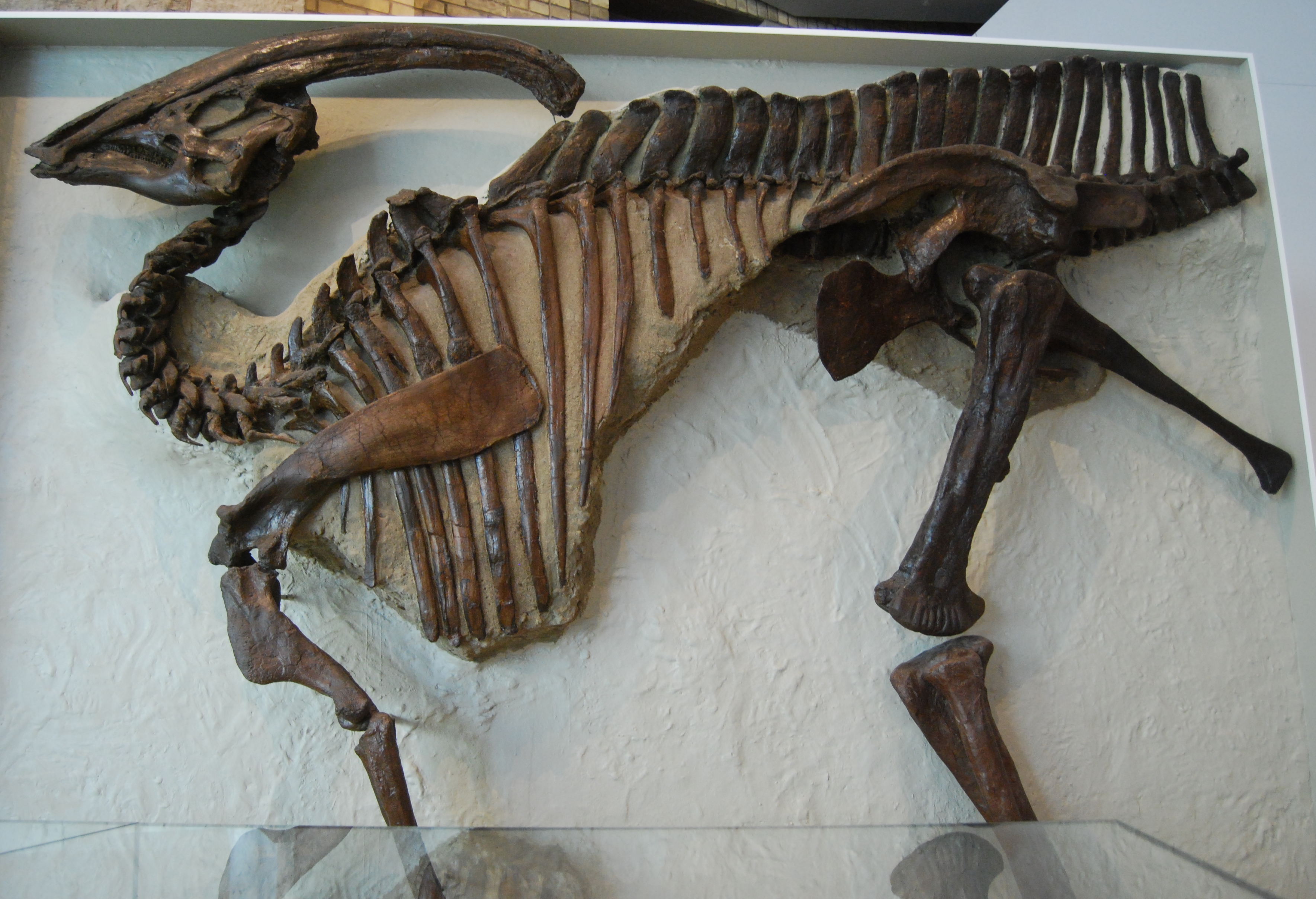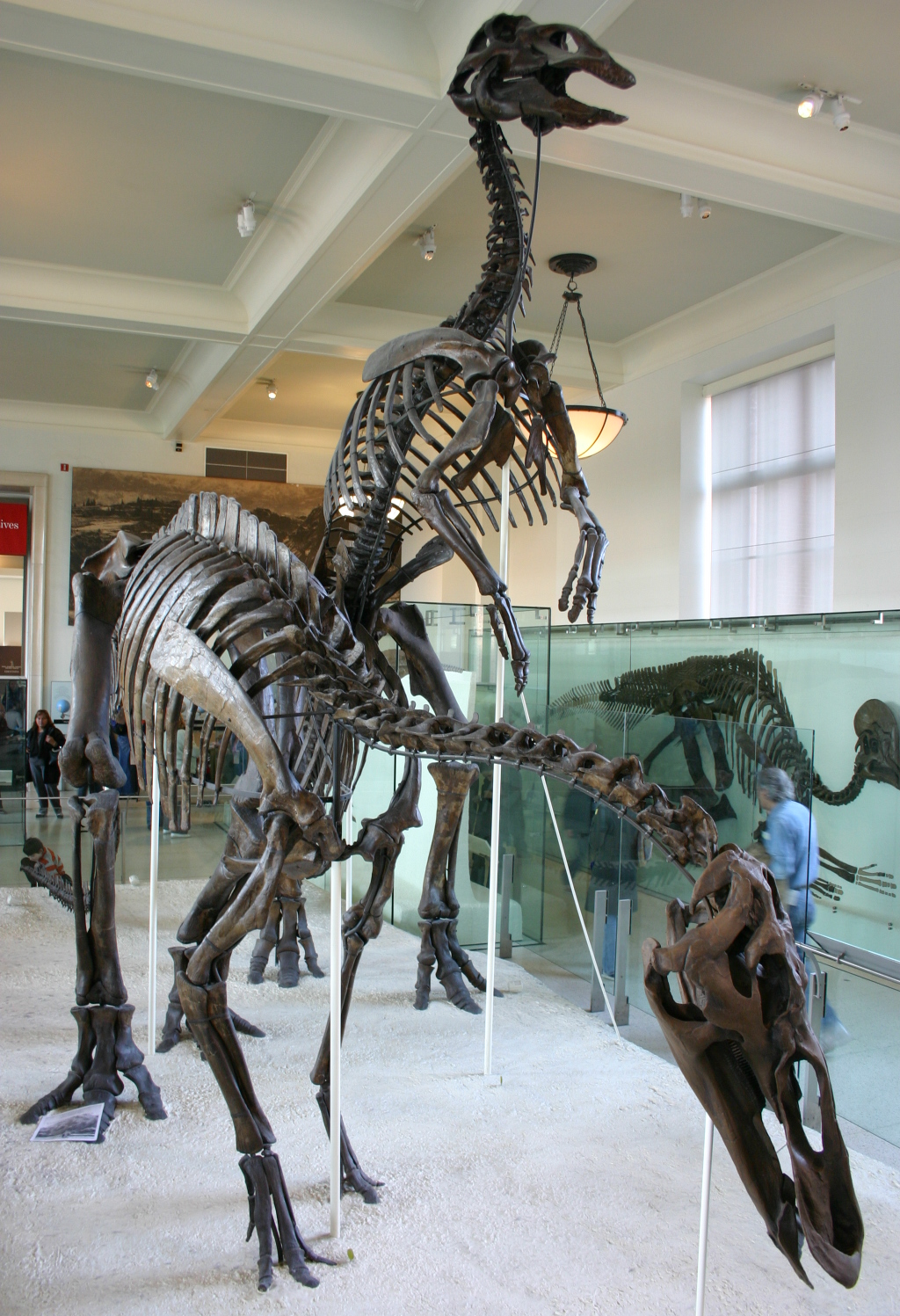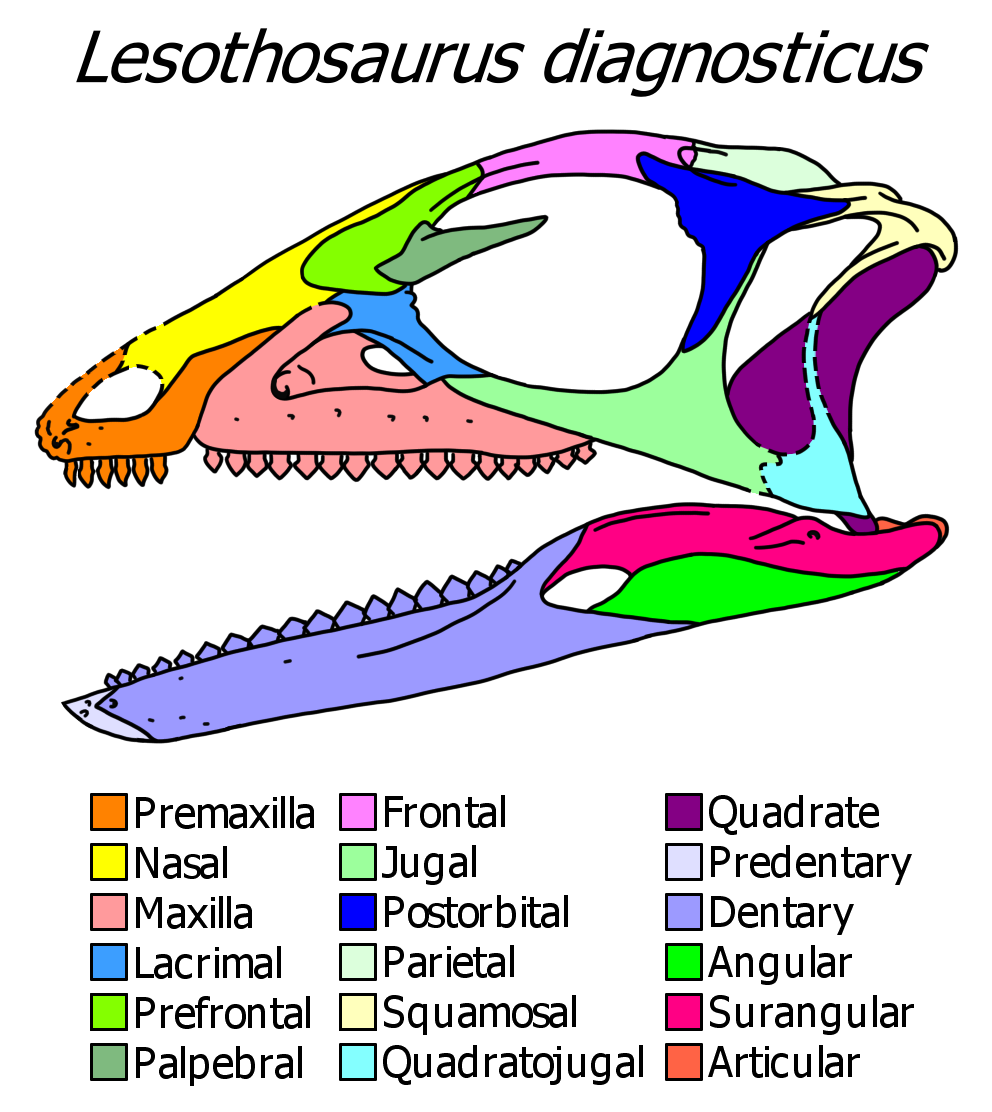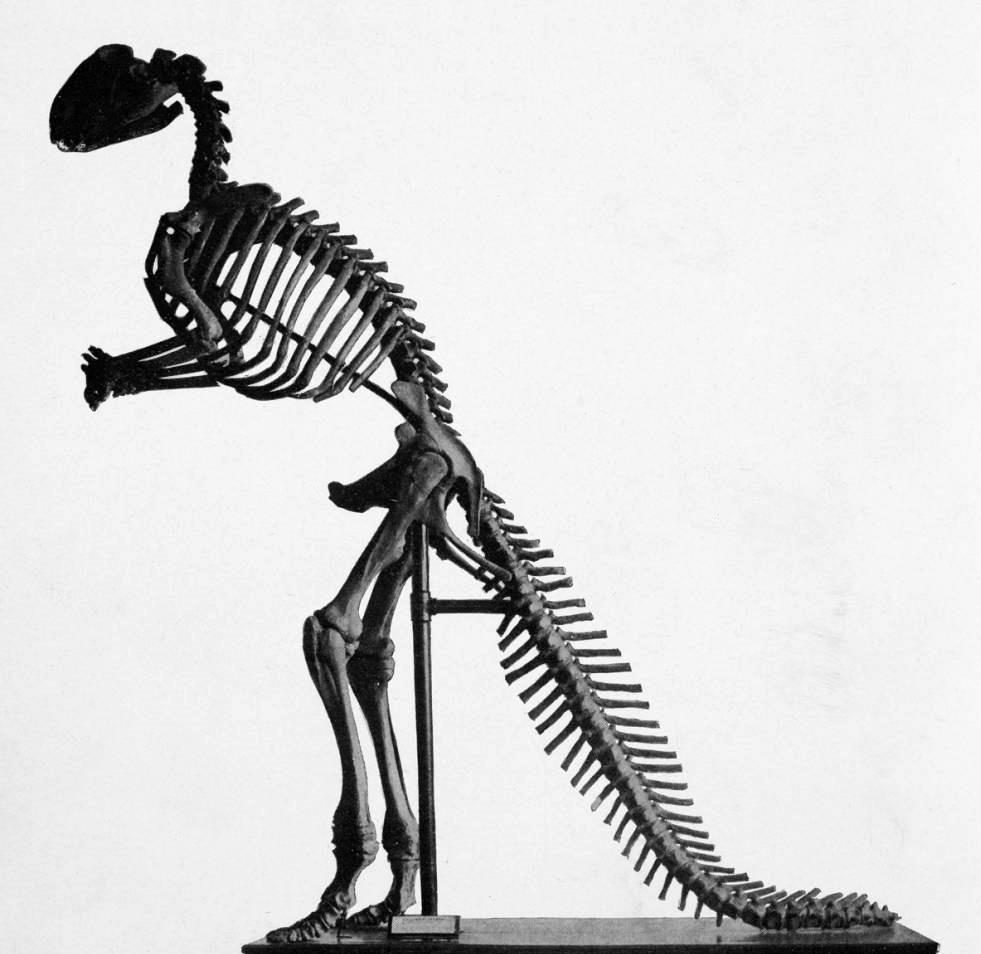|
Hadrosauridae
Hadrosaurids (), also hadrosaurs or duck-billed dinosaurs, are members of the ornithischian family Hadrosauridae. This group is known as the duck-billed dinosaurs for the flat duck-bill appearance of the bones in their snouts. The ornithopod family, which includes genera such as '' Edmontosaurus'' and '' Parasaurolophus'', was a common group of herbivores during the Late Cretaceous Period. Hadrosaurids are descendants of the Late Jurassic/Early Cretaceous iguanodontian dinosaurs and had a similar body layout. Hadrosaurs were among the most dominant herbivores during the Late Cretaceous in Asia and North America, and during the close of the Cretaceous several lineages dispersed into Europe, Africa, and South America. Like other ornithischians, hadrosaurids had a predentary bone and a pubic bone which was positioned backwards in the pelvis. Unlike more primitive iguanodonts, the teeth of hadrosaurids are stacked into complex structures known as dental batteries, which acted as e ... [...More Info...] [...Related Items...] OR: [Wikipedia] [Google] [Baidu] |
Edmontosaurus
''Edmontosaurus'' ( ) (meaning "lizard from Edmonton"), with the second species often colloquially and historically known as ''Anatosaurus'' or ''Anatotitan'' (meaning "duck lizard" and "giant duck"), is a genus of hadrosaurid (duck-billed) dinosaur. It contains two known species: ''Edmontosaurus regalis'' and ''Edmontosaurus annectens''. Fossils of ''E. regalis'' have been found in rocks of western North America that date from the late Campanian Stage (stratigraphy), age of the Cretaceous Period (geology), period 73 million years ago, while those of ''E. annectens'' were found in the same geographic region from rocks dated to the end of the Maastrichtian age, 66 million years ago. ''Edmontosaurus'' was one of the last non-bird, avian dinosaurs ever to exist, and lived alongside dinosaurs like ''Triceratops'', ''Tyrannosaurus'', ''Ankylosaurus'', and ''Pachycephalosaurus'' shortly before the Cretaceous–Paleogene extinction event. ''Edmontosaurus'' included two of the lar ... [...More Info...] [...Related Items...] OR: [Wikipedia] [Google] [Baidu] |
Lambeosaurinae
Lambeosauridae /ˌlæmbiəˈsɔːraɪniː/ (meaning 'lambe's lizards') is an extinct group of crested hadrosauroid dinosaurs. Description Size Uncertainty surrounds the size of lambeosaurs from the European continent. Hadrosaurs found there, alongside other dinosaurs, have traditionally been considered representatives of the phenomenon of insular dwarfism, as the continent was then made up of many smaller islands. Many fossil remains from the continent are smaller than those of hadrosaurs found elsewhere in the world, with only isolated remains indicating individuals of adult size by the standards of their relatives in North America and Asia. It remains possible, however, that at least some cases instead represent misidentification of juvenile remains.Dalla Vecchia, F. M. (2014). An overview of the latest Cretaceous hadrosauroid record in Europe. Hadrosaurs, 268-297.Dalla Vecchia FM, Gaete R, Riera V, Oms O, Prieto-Márquez A, Vila B, et al. The hadrosauroid record in the Maast ... [...More Info...] [...Related Items...] OR: [Wikipedia] [Google] [Baidu] |
Parasaurolophus
''Parasaurolophus'' (; meaning "beside crested lizard" in reference to ''Saurolophus'') is a genus of hadrosaurid "duck-billed" dinosaur that lived in what is now western North America and possibly Asia during the Late Cretaceous period, about 76.9–73.5 million years ago. It was a large herbivore that could reach over long and weigh over , and were able to move as a biped and a quadruped. Three species are universally recognized: ''P. walkeri'' (the type species), ''P. tubicen'', and the short-crested ''P. cyrtocristatus''. Additionally, a fourth species, ''P. jiayinensis'', has been proposed, although it is more commonly placed in the separate genus '' Charonosaurus''. Remains are known from Alberta, New Mexico, and Utah, as well as possibly Heilongjiang if ''Charonosaurus'' is in fact part of the genus. The genus was first described in 1922 by William Parks from a skull and partial skeleton found in Alberta. ''Parasaurolophus'' was a hadrosaurid, p ... [...More Info...] [...Related Items...] OR: [Wikipedia] [Google] [Baidu] |
Edmontosaurus Annectens
''Edmontosaurus annectens'' (meaning "connected lizard from Edmonton"), often colloquially and historically known as ''Anatosaurus'' (meaning "duck lizard"), is a species of flat-headed Saurolophinae, saurolophine hadrosaurid dinosaur from the late Maastrichtian Geologic time scale, age at the very end of the Cretaceous Period (geology), period, in what is now western North America. Remains of ''E. annectens'' have been preserved in the Frenchman Formation, Frenchman, Hell Creek Formation, Hell Creek, and Lance Formations. All of these formations are dated to the late Maastrichtian age of the Late Cretaceous period, which represents the last three million years before the Cretaceous–Paleogene boundary, extinction of the non-avian dinosaurs (between 68 and 66 million years agoHoltz, Thomas R. Jr. (2012) ''Dinosaurs: The Most Complete, Up-to-Date Encyclopedia for Dinosaur Lovers of All Ages,'Winter 2011 Appendix./ref>). ''E. annectens'' is also found in the Laramie Formation, ... [...More Info...] [...Related Items...] OR: [Wikipedia] [Google] [Baidu] |
Saurolophinae
Saurolophinae is a subfamily (biology), subfamily of hadrosaurid dinosaurs. It has since the mid-20th century generally been called the Hadrosaurinae, a group of largely non-crested hadrosaurs related to the crested sub-family Lambeosaurinae. However, the name Hadrosaurinae is based on the genus ''Hadrosaurus'' which was found in more recent studies to be more primitive than either lambeosaurines or other traditional "hadrosaurines", like ''Edmontosaurus'' and ''Saurolophus''. As a result of this, the name Hadrosaurinae was dropped or restricted to ''Hadrosaurus'' alone, and the subfamily comprising the traditional "hadrosaurines" was renamed the Saurolophinae. Recent phylogenetic work by Hai Xing indicates that ''Hadrosaurus'' is placed within the monophyletic group containing all non-lambeosaurine hadrosaurids. Under this view, the traditional Hadrosaurinae is resurrected, with the Hadrosauridae being divided into two clades: Hadrosaurinae and Lambeosaurinae. Classification Saur ... [...More Info...] [...Related Items...] OR: [Wikipedia] [Google] [Baidu] |
Ornithischia
Ornithischia () is an extinct clade of mainly herbivorous dinosaurs characterized by a pelvic structure superficially similar to that of birds. The name ''Ornithischia'', or "bird-hipped", reflects this similarity and is derived from the Greek stem ' (), meaning "bird", and ' (), meaning "hip". However, as theropod dinosaurs, birds are only distantly related to this group. Ornithischians with well known anatomical adaptations include the ceratopsians or "horn-faced" dinosaurs (e.g. ''Triceratops''), the pachycephalosaurs or "thick-headed" dinosaurs, the armored dinosaurs ( Thyreophora) such as stegosaurs and ankylosaurs, and the ornithopods. There is strong evidence that certain groups of ornithischians lived in herds, often segregated by age group, with juveniles forming their own flocks separate from adults. Some were at least partially covered in filamentous (hair- or feather- like) pelts, and there is much debate over whether these filaments found in specimens of '' Ti ... [...More Info...] [...Related Items...] OR: [Wikipedia] [Google] [Baidu] |
Hadrosaurus
''Hadrosaurus'' (; ) is a genus of hadrosaurid ornithopod dinosaurs that lived in North America during the Late Cretaceous Period in what is now the Woodbury Formation in New Jersey about 83.6 to 77.9 Ma. The holotype specimen was found in fluvial marine sedimentation, meaning that the corpse of the animal was transported by a river and washed out to sea. Some fossils are found in the Tar Heel/Coachman Formation. They were large animals ranging from and . Most of the preserved elements are very robust, unusual traits in hadrosaurs. ''Hadrosaurus'' were ponderously built animals equipped with keratinous beaks for cropping foliage and a specialized and complex dentition for food processing. ''Hadrosaurus foulkii'', the only species in this genus, is known from a single specimen consisting of much of the skeleton and parts of the skull. The specimen was collected in 1858 from the Woodbury Formation in New Jersey, US, representing the first dinosaur species known from more than ... [...More Info...] [...Related Items...] OR: [Wikipedia] [Google] [Baidu] |
Hadrosaurus Foulkii
''Hadrosaurus'' (; ) is a genus of hadrosaurid ornithopod dinosaurs that lived in North America during the Late Cretaceous Period in what is now the Woodbury Formation in New Jersey about 83.6 to 77.9 Ma. The holotype specimen was found in fluvial marine sedimentation, meaning that the corpse of the animal was transported by a river and washed out to sea. Some fossils are found in the Tar Heel/Coachman Formation. They were large animals ranging from and . Most of the preserved elements are very robust, unusual traits in hadrosaurs. ''Hadrosaurus'' were ponderously built animals equipped with keratinous beaks for cropping foliage and a specialized and complex dentition for food processing. ''Hadrosaurus foulkii'', the only species in this genus, is known from a single specimen consisting of much of the skeleton and parts of the skull. The specimen was collected in 1858 from the Woodbury Formation in New Jersey, US, representing the first dinosaur species known from more than ... [...More Info...] [...Related Items...] OR: [Wikipedia] [Google] [Baidu] |
Malefica
''Malefica'' (meaning "witch" or "sorceress") is a genus of hadrosaurid dinosaur from the Late Cretaceous (Campanian) Aguja Formation of Texas. The type and only species is ''Malefica deckerti''. Discovery and naming The holotype of ''Malefica'', TxVP 41917-1, is a partial left maxilla recovered from Bruja Canyon in Big Bend National Park. In 2002, it was assigned to the genus '' Kritosaurus'', as ''cf. K. navajovius''. Twenty years later, it was discovered to contain a number of useful diagnostic traits that allow it to be described as a new taxon, despite being fragmentary. The generic name, "''Malefica''", means "witch" or "sorceress" in Latin, referring to its discovery in Bruja Canyon (''bruja'' being Spanish for "witch"). The specific name, "''deckerti''", honors Frank Deckert, the specimen's discoverer and former superintendent of Big Bend National Park. Classification Prieto-Márquez & Wagner (2022) performed a phylogenetic analysis which recovered ''Malefica'' as ... [...More Info...] [...Related Items...] OR: [Wikipedia] [Google] [Baidu] |
Ornithopod
Ornithopoda () is a clade of ornithischian dinosaurs, called ornithopods (). They represent one of the most successful groups of herbivorous dinosaurs during the Cretaceous. The most primitive members of the group were bipedal and relatively small-sized, while advanced members of the subgroup Iguanodontia became quadrupedal and developed large body size. Their major evolutionary advantage was the progressive development of a chewing apparatus that became the most sophisticated ever developed by a non-avian dinosaur, rivaling that of modern mammals such as the domestic cow. They reached their apex of diversity and ecological dominance in the hadrosaurids (colloquially known as 'duck-bills'), before they were wiped out by the Cretaceous–Paleogene extinction event along with all other non- avian dinosaurs. Members are known worldwide. History of research In 1870, Thomas Henry Huxley listed Iguanodontidae (coined by Edward Drinker Cope a year earlier) as one of his three famil ... [...More Info...] [...Related Items...] OR: [Wikipedia] [Google] [Baidu] |
Gobihadros
''Gobihadros'' is a genus of basal hadrosauroid dinosaur that lived in Asia during the Late Cretaceous period in what is now the Bayan Shireh Formation (Cenomanian-Santonian). It contains only the type species ''Gobihadros mongoliensis''. It has an estimated length of . Discovery and naming Between 1993 and 2004, the Mongolian Palaeontological Center and the Japanese Hayashibara Museum of Natural Sciences excavated sites at Bayshin Tsav. Material was discovered of a basal hadrosauroid new to science. Tsogtbaatar treated this species in his dissertation of 2008. In 2019, the type species ''Gobihadros mongoliensis'' was named and described by Khishigjav Tsogtbaatar, David Bruce Weishampel, David Christopher Evans, and Mahito Watabe. The generic name combines references to the Gobi Desert and the Hadrosauroidea. The specific name refers to the provenance from Mongolia. Because the describing article appeared in an electronic publication, Life Science Identifiers were needed to ... [...More Info...] [...Related Items...] OR: [Wikipedia] [Google] [Baidu] |
Eotrachodon
''Eotrachodon orientalis'' (meaning "dawn ''Trachodon'' from the east") is a species of hadrosaurid that was 2016 in paleontology, described in 2016. The holotype was found in the Mooreville Chalk Formation (Upper Santonian) in Alabama in 2007 and includes a well-preserved skull and partial skeleton, making it a rare find among dinosaurs of Appalachia (Mesozoic), Appalachia. Another primitive hadrosaur, ''Lophorhothon'', is also known from the same formation, although ''Eotrachodon'' lived a few million years prior. A phylogenetic study has found ''Eotrachodon'' to be the sister taxon to the hadrosaurid subfamilies Lambeosaurinae and Saurolophinae. This, along with the other Appalachian hadrosaur ''Hadrosaurus'' and possibly ''Lophorhothon'', ''Claosaurus'' and Hypsibema missouriensis, both species of ''Hypsibema'', suggests that Appalachia was the ancestral area of Hadrosauridae. See also * Timeline of hadrosaur research *2016 in paleontology References Further reading [...More Info...] [...Related Items...] OR: [Wikipedia] [Google] [Baidu] |








